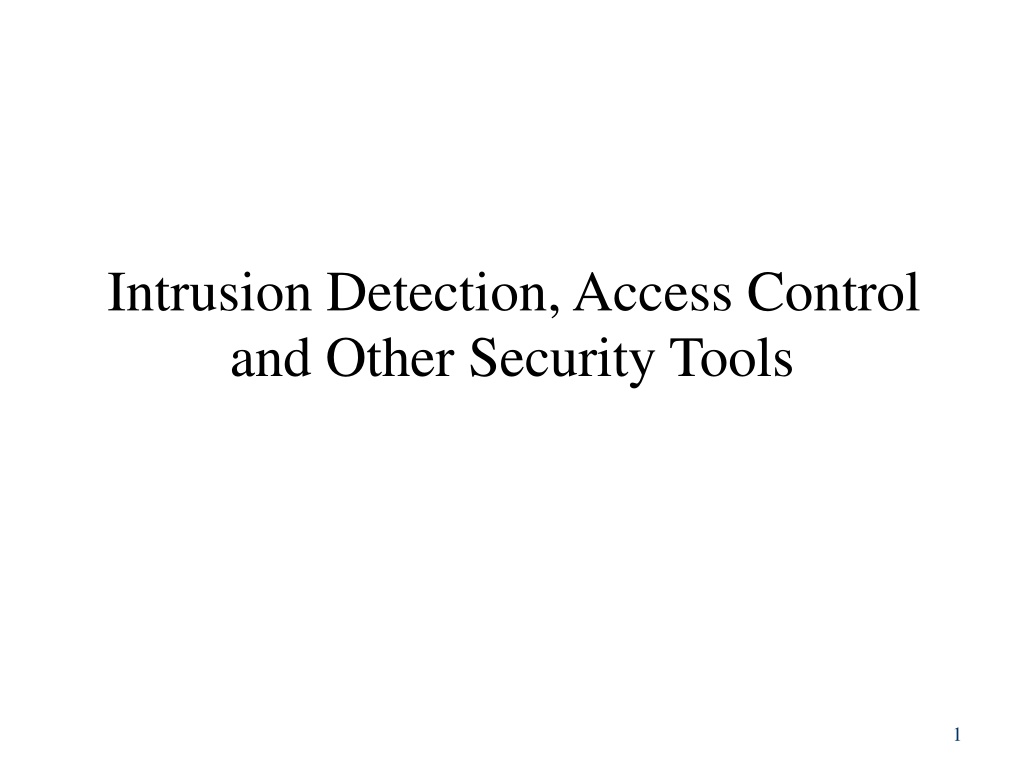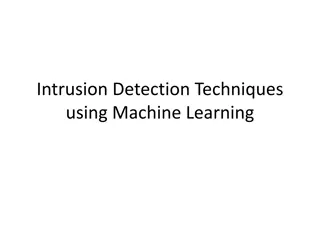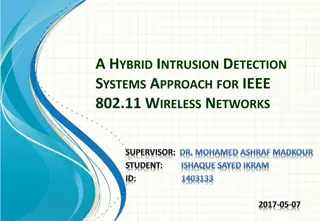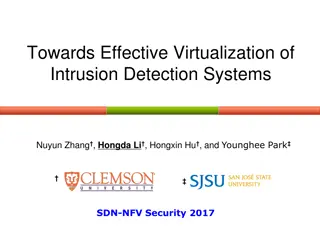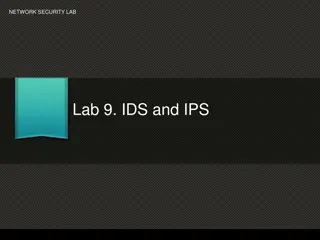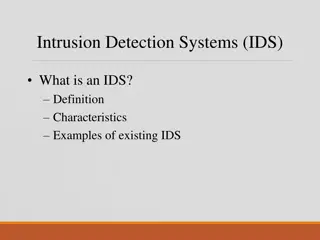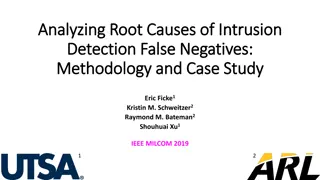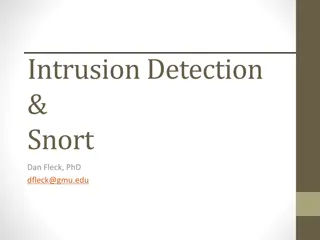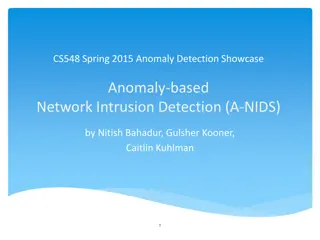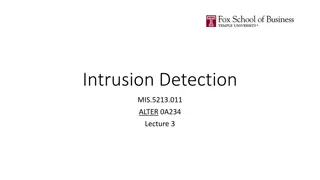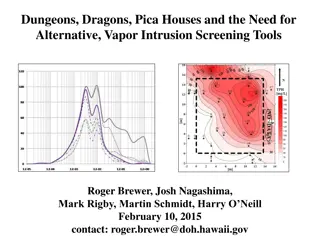Understanding Intrusion Detection and Security Tools
Explore the world of intrusion detection, access control, and security tools through terminology, systems, classifications, and methods. Learn about intrusion detection systems (IDSs), their terminology, alert systems, classification methods like signature-based and statistical anomaly-based approaches, and their advantages and disadvantages in safeguarding against cyber threats.
Download Presentation

Please find below an Image/Link to download the presentation.
The content on the website is provided AS IS for your information and personal use only. It may not be sold, licensed, or shared on other websites without obtaining consent from the author. Download presentation by click this link. If you encounter any issues during the download, it is possible that the publisher has removed the file from their server.
E N D
Presentation Transcript
Intrusion Detection, Access Control and Other Security Tools 1
Intrusion Terminology Intrusion: attack on information where malicious perpetrator tries to break into, disrupt system Intrusion detection: includes procedures and systems created and operated to detect system intrusions Intrusion reaction: covers actions organization takes upon detecting intrusion Intrusion correction activities: restore normal operations Intrusion prevention: actions that try to deter intrusions proactively 2
Intrusion Detection Systems (IDSs) Detects configuration violation, sounds alarm IDSs inform admins of trouble via e-mail, pagers Can configure systems to notify external security org. of break-in 3
IDS Terminology Alert, alarm: self-explanatory False negative: IDS fails to detect actual attack False positive: Attack alert when none occurred Confidence value: Estimate of attack probability Alarm filtering: self-explanatory 4
IDS Classification Methods IDS detection methods: Signature-based (sig IDS) Statistical anomaly-based (stat IDS operation: Network-based intrusion detection syst. (NIDS) Host-based IDS (HIDS) Application-based systems (AppIDS) IDS) 5
Classification (1): Sig. IDS Find network, host traffic patterns that match known signatures Advantage: Many attacks have distinct signatures Disadvantages: IDS s signature database must be updated to keep pace with new attacks Malicious code authors intentionally use tricks to fool these IDSs 6
Classification (1): Stat. IDS Statistical anomaly-based IDS sample network activity, compare to known normal traffic IDS sounds alarm when activity is outside baseline parameters Advantage: IDS can detect new types of attacks Disadvantages: Requires more overhead, compute power than signature-based IDSs May generate many false positives 7
Classification (2): NIDS Resides on computer or appliance connected to segment of an organization s network; looks for signs of attacks When examining packets, a NIDS looks for attack patterns Installed at specific place in the network where it can watch traffic going into and out of particular network segment 9
NIDS Signature Matching NIDSs look for attack patterns for detection Accomplished via certain implementation of TCP/IP stack: Protocol stack verification: look for invalid packets App. protocol verification: look at higher-order protocols for unexpected behavior or improper use 10
NIDS Advantages, Disadvantages Advantages Org. can monitor large network with few devices Passive; deployment minimally disrupts operations Less susceptible to attack; attackers may not detect them Disadvantages Can be overwhelmed by volume of network traffic Need to monitor all traffic Cannot analyze encrypted network packets Cannot determine if attack was successful Cannot detect some attacks (e.g., fragmented packets) 11
Classification (2): HIDS HIDS runs on a particular computer, monitors activity only on that system Benchmarks, monitors key system files; detects when intruders file I/O HIDSs work on principle of configuration management Unlike NIDSs, HIDSs can be installed to access info. that s encrypted in transit over network 12
HIDS Advantages, Disadvantages Advantages Disadvantages Vulnerable to attacks against host operating system, HIDS Cannot detect scans of multiple hosts, non-network devices HIDSs potential targets for denial- of-service (DoS) attack May use lots of disk space Possible large compute performance overhead on host systems Harder to manage than NIDSs Detect local events, attacks on host systems that NIDSs may not Can view encrypted traffic (as it has been decrypted on system) HIDSs unaffected by switched network protocols Can detect inconsistencies in apps, programs by examining audit logs 13
Application-Based IDS Application-based IDS (AppIDS) looks at apps for abnormal events AppIDS may be configured to intercept requests: File System Network Configuration Process s Virtual Memory Address Space 14
Advantages and Disadvantages of AppIDSs Advantages Aware of specific users; can observe interaction between apps and users Functions with encrypted incoming data Disadvantages More susceptible to attack Less capable of detecting software tampering May be fooled by forms of spoofing 15
Selecting IDS Approaches and Products Technical and policy considerations What is your systems environment? What are your security goals? What is your existing security policy? Organizational requirements and constraints What requirements are given from outside the org.? What are your org s resource constraints? ($$$) 16
IDS Control Strategies An IDS can be implemented via one of three basic control strategies Centralized: all IDS control functions are implemented and managed in a central location Fully distributed: all control functions are applied at the physical location of each IDS component Partially distributed: combines the two; while individual agents can still analyze and respond to local threats, they report to a hierarchical central facility to enable organization to detect widespread attacks 17
IDS Deployment Overview IDS system placement can be a black art Similar to what type of IDS should be use? question Need to balance organization s security needs with budget We can use NIDS and HIDS in tandem to cover both individual systems that connect to an org s networks and the networks themselves 21
Deploying NIDSs (1) NIST recommends four locations for NIDSs: Location 1: behind each external firewall, in the network DMZ Location 2: outside an external firewall Location 3: on major network backbones Location 4: on critical subnets 22
Deploying HIDS Setting up HIDSs: tedious, time-consuming (?) Steps: First: install HIDSs on most critical systems Next: install HIDSs on all systems or until organization reaches tolerable degree of coverage 24
Measuring Effectiveness of IDSs IDSs are evaluated using two dominant metrics: # of attacks detected in a known collection of probes Network bandwidth at which IDSs fail Example: At 1 Gbits/sec, IDS detected 95% of directed attacks against it Many vendors provide test suites for verification Example test suites: Record, retransmit real packet trace from virus/worm Perform same for malformed packets (e.g., SYN flood) Launch 25
Honeypots, Honeynets, and Padded Cell Systems Honeypots: decoy systems designed to lure potential attackers away from critical systems Design goals: Divert attacker from accessing critical systems Gather information about attacker s activity Encourage attacker to linger so admins can document event, respond Honeynets: collection of honeypots connected in a subnet Padded cell: honeypot protected in order to hinder compromise Typically works in tandem with traditional IDS When IDS detects attackers, it transfers them to special environment where they cannot cause harm (hence the name) 26
Honeypots: Advantages and Disadvantages Advantages Diverts attackers to targets they can t damage Admins have time to determine response Honeypots can monitor attackers actions; attack logs can help improve system security Honeypots may catch insiders snooping around network Disadvantages Legal implications are not well defined Honeypots effectiveness as security tech is unclear Expert attacker detecting honeypot may get angry, launch worse attack against org. Admins, security managers need expertise to use honeypots 27
Honeypot Examples Sources: Fred Cohen & Associates (http://all.net/WG/index.html); https://github.com/paralax/awesome-honeypots/ 28
Trap and Trace Systems Various techniques that detect intrusion, trace it to origin Trap consists of honeypot/padded cell, alarm Legal drawbacks to trap and trace: Enticement: attracts attacker to system by placing tantalizing info. in certain places Entrapment: lures person into committing crime for conviction purpose Enticement is legal/ethical; entrapment is not More info: D.J. Gottfried, Avoiding the Entrapment Defense in a Post-9/11 World, FBI Law Enforcement Bulletin, 1 Jan. 2012, https://leb.fbi.gov/articles/legal-digest/legal- digest-avoiding-the-entrapment-defense-in-a-post-911-world. 29
Scanning and Analysis Tools (1) Often used to collect information that attacker would need to launch successful attack Attack protocol: sequence of attacker s steps to attack target system/network Footprinting: determining what hostnames, IP addresses a target org. owns Fingerprinting: systematic survey of resources found in footprinting stage Useful for discovering weaknesses in org. s network or systems 30
Scanning and Analysis Tools (2) Hostname queries: nslookup, dig (Un*x) IPaddress ownership: whois, https://whois.domaintools.com/ Internet search queries: Proprietary , Confidential Also: https://tools.wordtothewise.com/ Sources: Self-taken screenshots; https://whois.domaintools.com 31
Port Scanners Tools used by attackers, defenders to identify computers on network (plus other info.) Can scan for certain computers, protocols, resources (or generic scans) Example: nmap (https://nmap.org/) Sources: https://nmap.org; self-taken screenshot 32
Firewall Analysis Tools Several tools automate discovery of firewall rules, assist admins in rule analysis Admins who are wary of using same tools that attackers use should remember: User intent dictates how gathered info. is used Need to understand ways to attack computer/network in order to defend it! Example: Nessus (https://www.tenable.com/products/nessus) 33
Packet Sniffers Tool that gathers network packets, analyzes them Can provide network admin with info. to solve networking issues (or attacker eavesdropping) For legal use: admin must be on org.-owned network and have consent from net. owners Example tool: Wireshark Source: Wikipedia (user SF007) 34
Wireless Security Tools Organization needs to consider wireless security in tandem with its deployed wireless networks Toolkits can sniff wireless traffic, scan hosts, and assess network privacy Don t use WEP! Example tools: Wireshark aircrack-ng Source: Flickr (user: raynedata) 35
Access Control Devices Access control: authenticates, authorizes users Authentication: validate a person s identity Authorization: specify what the person can do with computers, networks Recommended: use two types of auth. technology Four main ways to authenticate person: What a person knows (e.g., password); What a person has (e.g., Duo Mobile app code); Who a person is (e.g., fingerprint); What a supplicant produces (e.g., work badge) 36
Summary Intrusion detection system (IDS) detects configuration violation and sounds alarm Network-based IDS (NIDS) vs. host-based IDS (HIDS) Complex selection of IDS products that fit an organization s needs! Honeypots are decoy systems; two variations are honeynets and padded cell systems 37
Summary Scanning and analysis tools are used to pinpoint vulnerabilities in systems, holes in security components, and unsecured aspects network of Authentication is validation of prospective user s (supplicant s) identity 38
Reference [1] Class note by Adam C. Champion, Ph.D.
